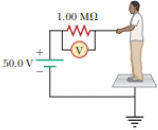
For the purpose of measuring the electric resistance of shoes through the body of the wearer standing on a metal ground plate, the American National Standards Institute (ANSI) specifies the circuit shown in Figure P27.14. The potential difference ΔV across the 1.00-MΩ resistor is measured with an ideal voltmeter. (a) Show that the resistance of the footwear is
(b) In a medical test, a current through the human body should not exceed 150 μA. Can the current delivered by the ANSI-specified circuit exceed 150 μA? To decide, consider a person standing barefoot on the ground plate.
Figure P27.14

Trending nowThis is a popular solution!

Chapter 28 Solutions
EBK PHYSICS FOR SCIENTISTS AND ENGINEER
- If the metal sphere on the Van de Graff has a charge of 0.14 Coulombs and the person has a mass of 62 kg, how much excess charge would the person need in order to levitate at a distance 25 cm from the center of the charged metal sphere? Assume you can treat both the person and the metal sphere as point charges a distance 25 cm from each otherarrow_forwardIf the metal sphere on the Van de Graff has a charge of 0.14 Coulombs and the person has a mass of 62 kg, how much excess charge would the person need in order to levitate at a distance 25 cm from the center of the charged metal sphere? Assume you can treat both the person and the metal sphere as point charges a distance 25 cm from each other (so that you can use Coulomb's Law to calculate the electrical force).arrow_forwardUsing Coulomb's Law, calculate the magnitude of the electrical force between two protons located 1 meter apart from each other. (Give your answer as the number of Newtons but as usual you only need to include the number, not the unit label.)arrow_forward
- Part A You want to get an idea of the magnitude of magnetic fields produced by overhead power lines. You estimate that a transmission wire is about 12 m above the ground. The local power company tells you that the line operates at 12 kV and provide a maximum of 60 MW to the local area. Estimate the maximum magnetic field you might experience walking under such a power line, and compare to the Earth's field. [For an ac current, values are rms, and the magnetic field will be changing.] Express your answer using two significant figures. ΟΤΕ ΑΣΦ VAΣ Bmax= Submit Request Answer Part B Compare to the Earth's field of 5.0 x 10-5 T. Express your answer using two significant figures. Ο ΑΣΦ B BEarth ? ? Tarrow_forwardHo propel 9-kN t. Boat 27. An elevator accelerates downward at 2.4 m/s². What force does the elevator's floor exert on a 52-kg passenger?arrow_forward16. 17 A CUIN Starting from rest and undergoing constant acceleration, a 940-kg racing car covers 400 m in 4.95 s. Find the force on the car.arrow_forward
- ----- vertical diste Section 4.6 Newton's Third Law 31. What upward gravitational force does a 5600-kg elephant exert on Earth?arrow_forward64. Two springs have the same unstretched length but different spring constants, k₁ and k₂. (a) If they're connected side by side and stretched a distance x, as shown in Fig. 4.24a, show that the force exerted by the combination is (k₁ + k₂)x. (b) If they're con- nected end to end (Fig. 4.24b) and the combination is stretched a distance x, show that they exert a force k₁k2x/(k₁ + k₂). www (a) FIGURE 4.24 Problem 65 www (b)arrow_forward65. Although we usually write Newton's second law for one-dimensional motion in the form F =ma, which holds when mass is constant, d(mv) a more fundamental version is F = . Consider an object dt whose mass is changing, and use the product rule for derivatives to show that Newton's law then takes the form F dm = ma + v dtarrow_forward
- If a proton is located on the x-axis in some coordinate system at x0 = -3.2 x 10-5 meters, what is the x-component of the Electric Field due to this proton at a position x = +3.2 x 10-5 meters and on the x axis as the y-axis is 0 giving a number of Newtons/Coulomb?arrow_forwardConsider a single square loop of wire of area A carrying a current I in a uniform magnetic field of strength B. The field is pointing directly up the page in the plane of the page. The loop is oriented so that the plane of the loop is perpendicular to the plane of the page (this means that the normal vector for the loop is always in the plane of the page!). In the illustrations below the magnetic field is shown in red and the current through the current loop is shown in blue. The loop starts out in orientation (i) and rotates clockwise, through orientations (ii) through (viii) before returning to (i). (i) Ø I N - - I N - (iii) (iv) (v) (vii) (viii) a) [3 points] For each of the eight configurations, draw in the magnetic dipole moment vector μ of the current loop and indicate whether the torque on the dipole due to the magnetic field is clockwise (CW), counterclockwise (CCW), or zero. In which two orientations will the loop experience the maximum magnitude of torque? [Hint: Use the…arrow_forwardPlease help with calculating the impusle, thanks! Having calculated the impact and rebound velocities of the ping pong ball and the tennis ball calculate the rebounding impulse: 1.Measure the weight of the balls and determine their mass. Tennis ball: 0.57 kg Ping Pong Ball: 0.00246 kg The impulse, I, is equal to the change in momentum, Pf-Pi. Note the sign change, i.e., going down is negative and up is positive. The unit for momentum is kg-m/s. The change is momentum, impulse, is often givens the equivalent unit of N-S, Newton-Secondarrow_forward
 Principles of Physics: A Calculus-Based TextPhysicsISBN:9781133104261Author:Raymond A. Serway, John W. JewettPublisher:Cengage Learning
Principles of Physics: A Calculus-Based TextPhysicsISBN:9781133104261Author:Raymond A. Serway, John W. JewettPublisher:Cengage Learning Physics for Scientists and EngineersPhysicsISBN:9781337553278Author:Raymond A. Serway, John W. JewettPublisher:Cengage Learning
Physics for Scientists and EngineersPhysicsISBN:9781337553278Author:Raymond A. Serway, John W. JewettPublisher:Cengage Learning Physics for Scientists and Engineers with Modern ...PhysicsISBN:9781337553292Author:Raymond A. Serway, John W. JewettPublisher:Cengage Learning
Physics for Scientists and Engineers with Modern ...PhysicsISBN:9781337553292Author:Raymond A. Serway, John W. JewettPublisher:Cengage Learning College PhysicsPhysicsISBN:9781305952300Author:Raymond A. Serway, Chris VuillePublisher:Cengage Learning
College PhysicsPhysicsISBN:9781305952300Author:Raymond A. Serway, Chris VuillePublisher:Cengage Learning
 College PhysicsPhysicsISBN:9781938168000Author:Paul Peter Urone, Roger HinrichsPublisher:OpenStax College
College PhysicsPhysicsISBN:9781938168000Author:Paul Peter Urone, Roger HinrichsPublisher:OpenStax College





